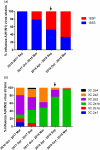Assessment of population susceptibility to upcoming seasonal influenza epidemic strain using interepidemic emerging influenza virus strains
- PMID: 31556360
- PMCID: PMC6805736
- DOI: 10.1017/S0950268819001717
Assessment of population susceptibility to upcoming seasonal influenza epidemic strain using interepidemic emerging influenza virus strains
Abstract
Seasonal influenza virus epidemics have a major impact on healthcare systems. Data on population susceptibility to emerging influenza virus strains during the interepidemic period can guide planning for resource allocation of an upcoming influenza season. This study sought to assess the population susceptibility to representative emerging influenza virus strains collected during the interepidemic period. The microneutralisation antibody titers (MN titers) of a human serum panel against representative emerging influenza strains collected during the interepidemic period before the 2018/2019 winter influenza season (H1N1-inter and H3N2-inter) were compared with those against influenza strains representative of previous epidemics (H1N1-pre and H3N2-pre). A multifaceted approach, incorporating both genetic and antigenic data, was used in selecting these representative influenza virus strains for the MN assay. A significantly higher proportion of individuals had a ⩾four-fold reduction in MN titers between H1N1-inter and H1N1-pre than that between H3N2-inter and H3N2-pre (28.5% (127/445) vs. 4.9% (22/445), P < 0.001). The geometric mean titer (GMT) of H1N1-inter was significantly lower than that of H1N1-pre (381 (95% CI 339-428) vs. 713 (95% CI 641-792), P < 0.001), while there was no significant difference in the GMT between H3N2-inter and H3N2-pre. Since A(H1N1) predominated the 2018-2019 winter influenza epidemic, our results corroborated the epidemic subtype.
Keywords: Influenza; population susceptibility; respiratory tract infections; serology.
Conflict of interest statement
None.
Figures


Similar articles
-
Determination of serum neutralization antibodies against seasonal influenza A strain H3N2 and the emerging strains 2009 H1N1 and avian H5N1.Scand J Infect Dis. 2011 Mar;43(3):216-20. doi: 10.3109/00365548.2010.539258. Epub 2010 Dec 9. Scand J Infect Dis. 2011. PMID: 21142624
-
Serum strain-specific or cross-reactive neuraminidase inhibiting antibodies against pandemic А/California/07/2009(H1N1) influenza in healthy volunteers.BMC Res Notes. 2015 Apr 10;8:136. doi: 10.1186/s13104-015-1086-z. BMC Res Notes. 2015. PMID: 25889924 Free PMC article.
-
Low population serum microneutralization antibody titer against the predominating influenza A(H3N2) N121K virus during the severe influenza summer peak of Hong Kong in 2017.Emerg Microbes Infect. 2018 Mar 6;7(1):23. doi: 10.1038/s41426-018-0041-1. Emerg Microbes Infect. 2018. PMID: 29511175 Free PMC article.
-
Association between Hemagglutinin Stem-Reactive Antibodies and Influenza A/H1N1 Virus Infection during the 2009 Pandemic.J Virol. 2016 Jun 24;90(14):6549-6556. doi: 10.1128/JVI.00093-16. Print 2016 Jul 15. J Virol. 2016. PMID: 27170747 Free PMC article.
-
Relative incidence and individual-level severity of seasonal influenza A H3N2 compared with 2009 pandemic H1N1.BMC Infect Dis. 2017 May 11;17(1):337. doi: 10.1186/s12879-017-2432-7. BMC Infect Dis. 2017. PMID: 28494805 Free PMC article.
Cited by
-
Seroprevalence of SARS-CoV-2 in Hong Kong and in residents evacuated from Hubei province, China: a multicohort study.Lancet Microbe. 2020 Jul;1(3):e111-e118. doi: 10.1016/S2666-5247(20)30053-7. Epub 2020 Jun 3. Lancet Microbe. 2020. PMID: 33230504 Free PMC article.
-
High neutralizing antibody titer in intensive care unit patients with COVID-19.Emerg Microbes Infect. 2020 Dec;9(1):1664-1670. doi: 10.1080/22221751.2020.1791738. Emerg Microbes Infect. 2020. PMID: 32618497 Free PMC article.
-
Temporal profiles of viral load in posterior oropharyngeal saliva samples and serum antibody responses during infection by SARS-CoV-2: an observational cohort study.Lancet Infect Dis. 2020 May;20(5):565-574. doi: 10.1016/S1473-3099(20)30196-1. Epub 2020 Mar 23. Lancet Infect Dis. 2020. PMID: 32213337 Free PMC article.
-
Improved Detection of Antibodies against SARS-CoV-2 by Microsphere-Based Antibody Assay.Int J Mol Sci. 2020 Sep 9;21(18):6595. doi: 10.3390/ijms21186595. Int J Mol Sci. 2020. PMID: 32916926 Free PMC article.
-
Interferon-gamma inhibits influenza A virus cellular attachment by reducing sialic acid cluster size.iScience. 2022 Mar 6;25(4):104037. doi: 10.1016/j.isci.2022.104037. eCollection 2022 Apr 15. iScience. 2022. PMID: 35330686 Free PMC article.
References
-
- Beysard N et al. (2018) Impact of the 2014–2015 influenza season on the activity of an academic emergency department. Internal and Emergency Medicine 13, 251–256. - PubMed
-
- Poon CM et al. (2019) Management decision of hospital surge: assessing seasonal upsurge in inpatient medical bed occupancy rate among public acute hospitals in Hong Kong. QJM 112, 11–16. - PubMed
-
- Putri W et al. (2018) Economic burden of seasonal influenza in the United States. Vaccine 36, 3960–3966. - PubMed
Publication types
MeSH terms
Substances
LinkOut - more resources
Full Text Sources
Medical

